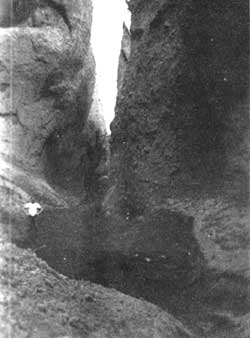A Sad Episode
By Norman D. Wild, Ranger-Naturalist
While on duty at Sinnott Memorial Overlook in the late afternoon of August 15th, I received an unexpected visit from Ranger Joseph Meeker. Cupped in his hand was the feathery bundle of a frightened mountain bluebird, Sialia currucoides (Bechstein). The bird, a female, (the male of the species is a much deeper blue) had been struck by an automobile. Its leg was presumably broken.
I placed the bird in a binocular case, the only available container, and set it on a shelf in the back room until closing time. The lid was left ajar, so the bird would not suffocate. It did not appear too perturbed with its new surroundings, but remained there quietly.
An examination later, at the naturalist laboratory, showed there were no broken bones in the leg. Had a break occurred, the injured member could have been splinted, with a fair chance for recovery. There was very little that could be done, as the pelvic region was badly damaged. It was put gently in a small cage with a dish of water. The bluebird hobbled so violently that a cover was used to quiet its actions.
The next morning, the poor creature, though still alive, was sitting uncomfortably in the corner of the cage, in much pain. Its chances of recovery nil, a few drops of ether, that merciful messenger of sleep, quickly ended the suffering.
I shall always remember this sad episode. Perhaps our departed friend, wherever it may be, is chirping the song “Bluebird of Happiness.”
A Journey Into Llaos Hallway
By Willis G. Downing, Ranger-Naturalist
Most visitors to Crater Lake National Park are impressed by the geology of the rim wall and the story of the collapse of a mighty mountain. The formation of Crater Lake did provide an area worthy of preservation as a National Park. It is fortunate, too, that the park boundaries include geologic formations outside the caldera which, while not of National Park status in themselves, are of interest to both the employees of the park and the visitors. The spectacular gorges carved out of pumice and scoria flows by Annie, Castle, and Sand Creeks are examples.
Llaos Hallway is a lesser chasm created by Whitehorse Creek, a small tributary of Castle Creek. Erosion through scoria deposits by the flowing of Whitehorse Creek has carved out a chasm which is two hundred feet deep in some places, yet narrow enough to be spanned at the top by outstretched arms.
Late in August of 1955 two of the fire guards (Fred La Bar and Jim Pritchard) and I decided we would like to take a journey into Llaos Hallway. After obtaining permission from the rangers’ office, we set out in Fred La Bar’s Model A, whose construction, by good chance, makes it an excellent vehicle to drive through the pumice-laden, sand-like roads in the park. This time we did not need to enter a fire road, but parked along the West Entrance road alongside an emergency telephone.
As evidence of the fact that this was a real first adventure for all of us, we did not immediately find Whitehorse Creek, as we should have, but rather picked up an even smaller stream-bed nearby which ran into Whitehorse Creek at a point where the walls of Llaos Hallway were about fifty feet high. Whitehorse was just a trickle.
 “Llaos Hallway, N.P.S. photo.” |
Now the moments of discovery began. Stepping and jumping from rock to rock, we usually avoided getting wet. In some spots there were drops of four to six feet which required adroit cooperation or, perhaps, well placed jumps. We always kept in mind, of course, the fact that we would want to ascend again what we had just descended. In two spots we encountered snow banks protected even from the hot summer sun by deep shade. These banks can sometimes present moot problems. Should you go under them with the stream? Or are they strong enough and situated so that it is best to go over them? We did both; once we went under, and once over.
As we continued down this slit, the sky looked farther and farther away. One hundred and fifty feet above us was a crack and sunlight. Sometimes we could touch both walls at the bottom with outstretched arms. But as we continued down, the canyon assumed a teardrop, cavelike shape. It was obvious that stream action had been undercutting and that the walls above us could fall in large or small chunks at any time.
Toward the end of the Hallway, we saw that this deduction was correct. A section of the wall ahead had collapsed, damming up the stream and forming a pool about twenty feet in width and forty feet long. We judged the water over six feet deep. This water was so cold that even the intrepid explorer, Fred La Bar, was persuaded that this should be the end of our venture. As we stood contemplating the pool, rocks two to six inches in diameter fell into the water from the walls above us. We were protected from their fall by the overhanging nature of the wall above. Any rocks dislodged immediately above us would have fallen only six to ten feet.
As we turned back, I felt that this was not the place to let out with an ape cry or a Swiss yodel. This was certainly an area of rapid erosion in terms of geologic time. We were beneath a spot where a misplaced footstep of a golden-mantled ground squirrel could cause a shower of medium sized rocks.
Continuing back up Llaos Hallway, we saw curves and formations we had not seen before. For a trail traversed from the opposite direction almost always reveals something overlooked or unseen from the wall the other way.

